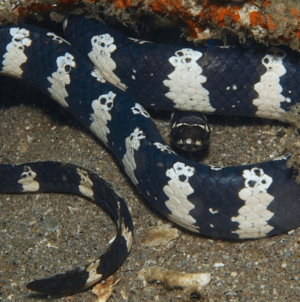Turtleheaded sea snake facts for kids
Quick facts for kids Turtleheaded sea snake |
|
|---|---|
 |
|
| Conservation status | |
| Scientific classification | |
| Genus: |
Emydocephalus
|
| Species: |
annulatus
|
| Synonyms | |
|
Emydocephalus szczerbaki |
|
The turtleheaded sea snake (Emydocephalus annulatus), also known as the egg-eating sea snake, is a special type of sea snake. You can find these snakes in the waters around Australia and some Pacific Islands. This includes places like the Philippines and the Loyalty Islands near New Caledonia. They live in different areas, for example, near the Great Barrier Reef on Australia's east coast and in the Timor Sea reefs on the west. However, you won't find them in the Gulf of Carpentaria along the north coast.
What Does the Turtleheaded Sea Snake Look Like?
This snake gets its name from its short, blunt head, which looks a bit like a turtle's. It's a medium-sized snake with a slim body. Its color can vary a lot! Some snakes are just one color, while others have cool patterns. These patterns often look like white or yellow bands with dark rings around their bodies.
The scales on top of its head are large and smooth. The scale at the very tip of its nose is shaped like a cone. The second of the three scales above its mouth is the biggest. Its body has 15 to 17 rows of smooth, overlapping scales. It also has special scales on its belly (125-145 of them) and under its tail (20-33 of them). This snake can grow up to about 103 centimeters (about 40 inches) long.
The color of a snake can affect how much algae sticks to its body. Darker, plain-colored snakes tend to get more algae buildup than lighter, patterned ones. This extra weight from the algae can slow a snake down by up to 20%! Snakes that are slowed down often hide more among the coral. Snakes with little or no algae are usually out actively looking for food. Interestingly, having algae doesn't seem to affect how long they live. Lighter snakes aren't more likely to survive than darker ones.
What Do Turtleheaded Sea Snakes Eat?
The Emydocephalus is quite unique among sea snakes because it doesn't have teeth on the roof of its mouth. Unlike most snakes that hunt large meals, the turtleheaded sea snake prefers to eat smaller, more frequent snacks. This sea snake eats only fish eggs! They especially like the eggs of fish that attach their eggs to the seafloor. These include eggs from fish like damselfish, blennies, and gobies.
Bigger snakes tend to eat more damselfish eggs. These eggs are often found in open areas. Smaller snakes might prefer eggs from blennies and gobies, which are hidden in narrow cracks and crevices.
Turtleheaded sea snakes usually stay in one area and don't move around much. They are quite "sedentary," which means they like to stay put. This might be because they remember where the fish nests are located. By staying in the same place, they can regularly visit the same feeding spots. Their way of eating is sometimes compared to how a grazing mammal eats grass. This unusual feeding method shows how snakes have adapted in many amazing ways over time.
Why Are These Snakes Disappearing?
In recent years, the number of turtleheaded sea snakes has been going down. This has been noticed in places like the New Caledonian Lagoon. For example, in 2003, people saw more than six snakes per day in a protected coral reef area. But by 2011, they saw less than two per day. Similar studies in 2006 at Ashmore Reef in northern Australia also showed a drop in their numbers.
The exact reason for this decline isn't fully clear. However, experts believe it might be due to things like human activities, damage to their homes from tourism, and coral bleaching. Changes in their habitat and diet might also play a role.


